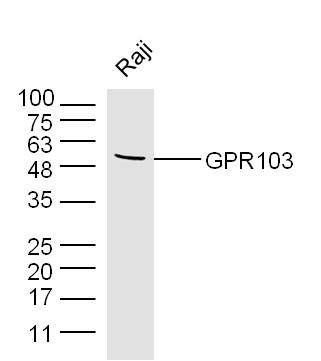G protein-coupled receptors (GPRs) are a protein family of transmembrane receptors that transmit an extracellular signal (ligand binding) into an intracellular signal (G protein activation). GPR signaling is an evolutionarily ancient mechanism used by all eukaryotes to sense environmental stimuli and mediate cell-cell communication. All of the receptors have seven membrane-spanning domains and the extracellular parts of the receptor can be glycosylated. These extracellular loops also contain two highly conserved cysteine residues which create disulfide bonds to stabilize the receptor structure. GPR103 is a 455-amino acid protein with highest expression in the brain, retina, trigeminal ganglion, hypothalamus and vestibular nucleus. In peripheral tissues, GPR103 is expressed only in the heart, kidney and testis. GPR103 may regulate adrenal function. A hypothalamic neuropeptide of the RFamide family (26RFa) acts as an endogenous ligand for GPR103.
Function:
Receptor for the orexigenic neuropeptide QRFP. The activity of this receptor is mediated by G proteins that modulate adenylate cyclase activity and intracellular calcium levels.
Subcellular Location:
Cell membrane.
Tissue Specificity:
Expressed widely in the brain with high levels in the hypothalamus, trigeminal ganglia and vestibular neurons, and moderate levels in the amygdala, cortex, pituitary, hippocampus, thalamus, caudate nucleus and medulla oblongata. In peripheral tissues, expressed at high levels in the retina and at moderate levels in the heart, kidney, testis and thyroid.
Similarity:
Belongs to the G-protein coupled receptor 1 family.
SWISS:
Q96P65
Gene ID:
84109
Database links:
Entrez Gene: 529752 Cow
Entrez Gene: 483846 Dog
Entrez Gene: 100072268 Horse
Entrez Gene: 84109 Human
Entrez Gene: 229214 Mouse
Entrez Gene: 310327 Rat
Omim: 606925 Human
SwissProt: Q96P65 Human
SwissProt: P83861 Mouse
SwissProt: P83858 Rat
Unigene: 368977 Human
Unigene: 330975 Mouse
Unigene: 162584 Rat
| Picture |
Sample: Raji (human)Cell Lysate at 40 ug
Primary: Anti-GPR103(SL13512R) at 1/300 dilution
Secondary: IRDye800CW Goat Anti-Rabbit IgG at 1/20000 dilution
Predicted band size: 49 kD
Observed band size: 49 kD
|
|
|
